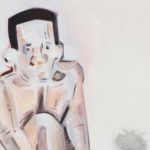标签为 “Neugerriemschneider” 的文章
-
A Guide to Brussels Gallery Weekend – 布鲁塞尔画廊周 …
2018.10.18 · 发表评论‘Wiggle’
Galerie Greta Meert
7 September – 20 OctoberUnfurling across Galerie Greta Meert’s three floors, ‘Wiggle’ showcases the work of 15 international artists who use sculpture to interrogate the notion of materiality beyond simple denotation. Donald Judd uses stacks and blocks to create non-referential works of art while Terry Adkins assembles locally found objects such as musical instruments and reintroduces them as resounding installations. Katinka Bock experiments with natural materials, using clay ceramic liquid and webbing to articulate thoughts on history and geography and on the other end of the spectrum, Diane Simpson’s work transfigures clothing, furniture and industrial architecture into sculptures that are an observation of the architectonic vs. the domestic. Countering painter Ad Reinhardt’s modernist joke that a sculpture is a thing that you ‘bump into while you back up to look at a painting’, the group show pushes back against convention, giving the form more leeway than tradition has previously allowed. – “摇摆” -
Visual Essay: Tools – 视觉散文:工具
2018.08.05 · 发表评论The artist Simon Starling photographs Giorgio Griffa’s studio in TurinThis visual essay is the continuation of a collaboration with the Turin-based painter Giorgio Griffa, which began last year following the discovery of a very particular brush at an urushi [lacquer] workshop in Wajima, Japan. Only 5 cm wide with a flat wooden handle, the brush is employed to apply the critical final coat of lacquer to tableware and furniture in this painstaking, and seemingly anachronistic, process, which dates back to the prehistoric Jomon period (14,000–1,000 BCE). Crucially, its bristles are made from the hair of Japanese women pearl divers or ama. I purchased one of these highly evocative objects with the intention of using it in an artwork yet, for some time, I was daunted by the idea of making marks with it. In May last year, however, I found myself sitting with Giorgio at a dinner to celebrate his participation in the Venice Biennale and realized there and then that I should ask him to collaborate on the work. There seemed to be something in the nature of the brush that aligned with his measured yet exuberant (and often calligraphic) mark-making. His generous response consisted of three cypher-like, ink-on-paper works organized within a grid of folds that led, in turn, to a series of similarly gridded annotations on my part – annotations which reconnected that very particular tool to its origins.
When I arrived with my 8 x 10-inch plate camera to photograph Giorgio’s studio in late December last year, I found a small trestle table in the middle of the main space with a pile of neatly folded canvases sitting on top. (The artist has used exclusively unstretched, unprimed pieces of canvas, burlap and linen as supports for his paintings since the mid-1970s.) This modest stack – no higher than 30 cm – would comprise, I was told, the entirety of his forthcoming solo exhibition at Camden Arts Centre, London. In folded form, the paintings asserted a quiet materiality; the textiles – in a range of white, cream and brown hues – often frayed at the edges. Even when hung, simply with pins along the top edge, the works retain a sense of being objects that exist resolutely in time and space. Seeing this little stack of paintings and, later, the studio’s remarkable archive – which houses much of the artist’s output from the last 40 years or more – in geological strata-like piles, I realized that I’d brought the right tool to photograph the space. The slowness (exposures can last many minutes), insistent materiality and process-oriented nature of large-format, silver-based photography rhymed with Giorgio’s practice in ways that I hadn’t fully anticipated: even the camera’s gridded, ground-glass focus screen seemed to echo his paintings’ structuring folds. The resulting images are, I hope, a celebration of the lean economy and subtle materiality of these extraordinary artworks. – 艺术家西蒙·斯塔林拍摄Giorgio Griffa的工作室在TurinThis视觉散文是继续与都灵的画家吉奥吉奥格里夫合作,从去年开始发现一个非常特别的刷子在乌鲁木齐[漆]车间在日本轮岛。只有5厘米宽,有一个扁平的木制手柄,刷子被用来将油漆的最终涂层涂抹到餐具和家具上,这是一种痛苦的,似乎是过时的工艺,可以追溯到史前的乔门时期(14000—1000 BCE)。最重要的是,它的鬃毛是由日本妇女珍珠潜水员或AMA的头发制成的。我买了其中的一个高度唤起的对象,目的是使用它在一个艺术品,但有一段时间,我感到害怕的想法做标记与它。然而,去年5月,我发现自己和吉奥吉奥坐在一起庆祝他参加威尼斯双年展,并意识到我应该请他在这项工作上合作。在画笔的本质上似乎有一些东西与他测量的,但仍然旺盛的(通常是书法)标记相一致。他慷慨的回应包括三个类似于Cyfer-Script的墨水,在一个折叠的网格中组织起来,这导致了一系列类似的网格注释在我的部分-注释中重新连接了一个非常特殊的工具到它的起源。























